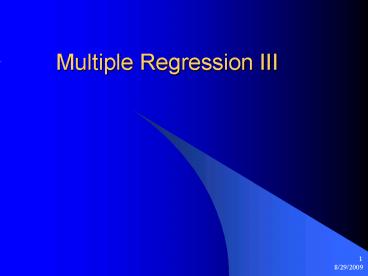Multiple Regression III - PowerPoint PPT Presentation
1 / 10
Title: Multiple Regression III
1
Multiple Regression III
2
Topic 1. Dummy Variables
- Sometimes, you have categorical variables that
you would like to use as independent variables in
a regression. - Examples might include gender, religion, race,
etc.. - For dichotomous variables, you simply include a
variable that is coded as 1 for one category and
zero for the other. - e.g. female 1 and male 0.
- In this case, the regression coefficient is
interpreted as the difference in the dependent
variable between men and women. - We call these kinds of variables dummy variables.
3
- Note to self
- Draw a scatterplot on the board using Xs to
denote men and Os to denote women, where men the
distribution of men is shifted above the
distribution of women, but the slope of the line
is essentially the same.
4
Dummy Variables cont.
- Polychotomous variables are trickier than
dichotomous variables. - One variable would not be very effective at
measuring the effect of a polychotomous variable
whose categories lack a clear ordering. - For example, consider the regression model
- Income B0 B1 Race B2 Yrs Education B3
Yrs Experience - What is wrong with this model?
5
Dummy Variables cont.
- If there were only two races, then we could
estimate the model with race coded such that
blacks 1 and whites 0. - Income B0 B1 Race B2 Yrs Education B3 Yrs
Experience - However, there are multiple categories of race,
and we wouldnt want to say that, Asians had a
bit more race than whites but less race than
blacks. - Instead, we use a set of dummy variables in
order to describe the polychotomous variable.
Each dummy variable in the set describes whether
or not an individual belongs to a certain
category in the model.
6
Dummy Variables cont.
- Example to describe a polychotomous variable for
race that contained the categories black, white ,
Asian, and Latino, we could use the following
variables - BlackVar 1 for blacks, 0 for all others
- WhiteVar 1 for whites, 0 for all others
- LatinoVar 1 for Latinos, 0 for all others
- Each of these variables would then be included in
a regression model - Income B0 B1 BlackVar B2 WhiteVar B3
LatinoVar - B4 Yrs Education B5 Yrs Experience
- Why dont we include a variable for Asians?
- The regression coefficients are then interpreted
as the effect of being in Category X as compared
to being in the excluded group. Therefore, in the
above example, B1 gives the increase/decrease in
income for blacks relative to Asians.
7
Dummy Variables cont.
- Example from Crime and Temp Data set.
8
Topic 2. Interaction Terms
- Sometimes theory predicts that the regression
coefficient for a particular independent variable
will not be constant for all observations. - For example, the effect of education on income
might be different for men and women. - In this case, the following regression model will
not be adequate - Income B0 B1 Male B2 Yrs Education B3
Yrs Experience - Why not? What would you do instead?
9
Interactions Terms cont.
- A superior method would be to relax the
assumption that B2 was identical for both men and
women by adding an additional variable. - For each observation, define this new variable as
follows maleXeduc Male Yrs Education - This new variable allows us to measures how the
effect of education differs for men and women
when we estimate the following regression model. - Income B0 B1 Gender B2 Yrs Education B3
Yrs Experience - B4 maleXeduc
- Suppose B4 3, then that would mean that for
each additional year of education, a male would
gain three additional units of income compared to
a female. - Continuing the example, suppose you had a male
and a female with 12 years of school. If each
went to college for 4 years, then the males
income would rise 12 units of income more than
the females.
10
Interaction terms
- Draw a scatterplot to illustrate the difference
between an intercept shift with just a dummy
variable and a slope shift due to an interaction
term.































